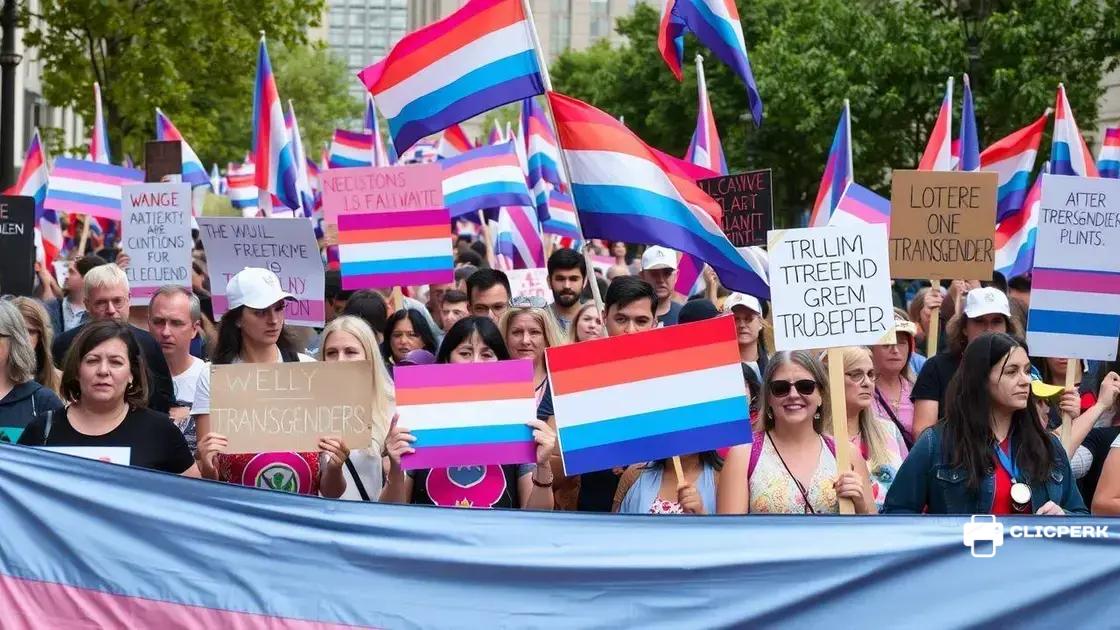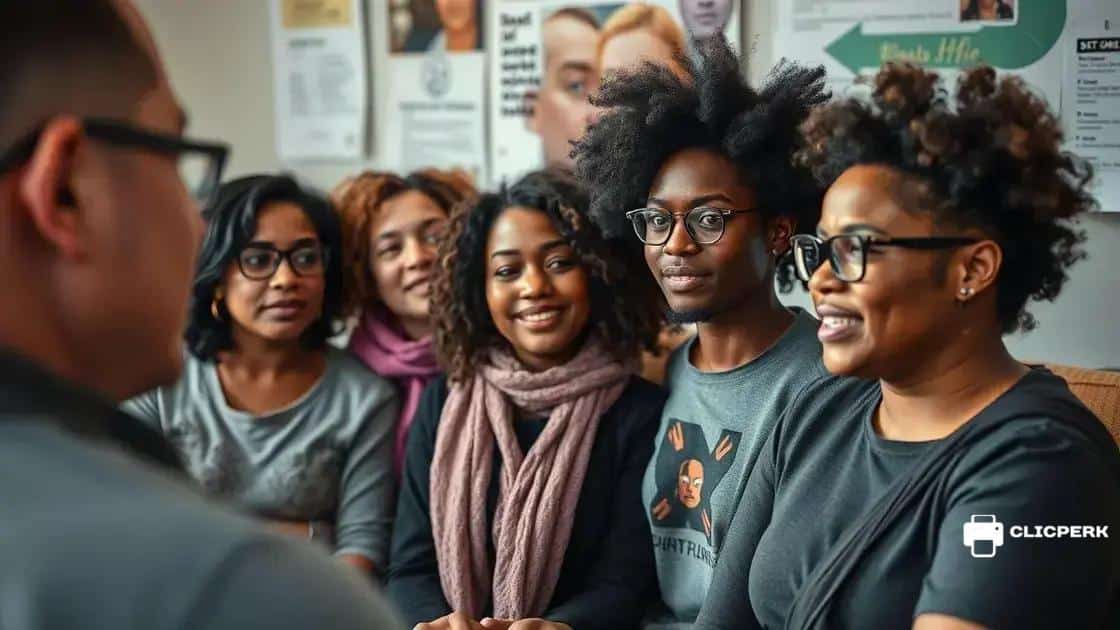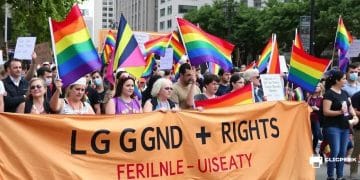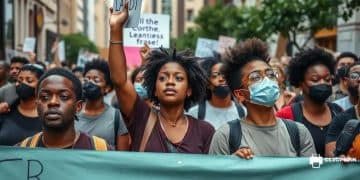Transgender rights protests that are changing the landscape

Transgender rights activism focuses on achieving equality, legal protections, and societal acceptance for transgender individuals, driven by community support and advocacy from allies.
Transgender rights protests are increasingly becoming a focal point for social change. Have you ever wondered how these movements resonate beyond their immediate locations? Here’s a look at their impact.
Understanding the history of transgender rights
Understanding the history of transgender rights is essential to grasp the advancements we see today. From early movements to modern activism, each step has played a crucial role in shaping social perceptions and laws.
Early Beginnings
The fight for transgender rights has roots that trace back many decades. In the mid-20th century, transgender individuals began to assert their rights more visibly. One notable event was the formation of the Mattachine Society in the 1950s, which advocated for LGBTQ+ rights.
Key Milestones
Several key milestones mark the journey toward equality:
- The Stonewall Riots of 1969, which ignited the modern LGBTQ+ movement.
- The first transgender pride march in the 1970s, raising awareness and visibility.
- Legal recognition of gender identity in various countries, paving the way for more rights.
These events weren’t just significant; they created a ripple effect that contributed to changes in legislation and public perception.
Modern Developments
In recent years, the conversation has expanded significantly. More individuals are openly identifying as transgender, and discussions about their rights have become more mainstream. Activist groups, such as the Transgender Advocacy Network, work tirelessly to push for both legal protections and social acceptance.
This ongoing struggle involves challenges, from healthcare rights to social discrimination. It demonstrates the resilience of the transgender community and the importance of raised voices in amplifying issues.
By learning about the history of transgender rights, we understand the context of today’s protests and the ongoing challenges faced by many. Each achievement is a testament to collective efforts and courage, fueling the momentum toward a more inclusive future. This history isn’t just about the past; it inspires current and future generations to continue advocating for equality.
Key events in recent transgender rights protests
Key events in recent transgender rights protests have showcased the determination and resilience of the community. These protests are not just marches; they are powerful statements of identity and demand for change.
The 2019 World Pride in New York
This historic event commemorated the 50th anniversary of the Stonewall Riots. Thousands gathered to honor the past while pushing for future rights. The celebration was a vibrant mix of parades, rallies, and workshops, focusing on transgender visibility and equality.
Black Trans Lives Matter Protests
In the wake of violence against transgender individuals, particularly Black transgender women, protests erupted across the globe. These events highlighted systemic racism and discrimination, demanding urgent reforms and protections for marginalized communities.
- Started in 2020, these protests have drawn attention to injustices.
- Activists emphasized the need for intersectional approaches within the LGBTQ+ movement.
- Many cities hosted vigils to honor those lost to violence.
These gatherings not only raised awareness but also united various communities, showcasing the importance of collaboration in the fight for rights.
Legislative Advocacy Days
Protesters have also organized legislative advocacy days to directly address policymakers. These days are crucial for:
- Highlighting issues that affect the transgender community.
- Encouraging lawmakers to support protective legislation.
- Engaging the public in discussions about rights and safety.
Through these events, advocates strive to bridge the gap between community needs and legislative actions, ensuring that transgender rights remain a priority.
As the landscape evolves, each protest reinforces the call for justice and equality. Individuals are coming together, fueling a movement that is rooted in history and driven by hope for a better future.
Voices from the front lines: personal stories

Voices from the front lines of transgender rights activism provide powerful insights into the personal experiences that drive the movement. Each story reveals unique challenges and triumphs, illustrating the ongoing fight for equality and recognition.
Stories of Resilience
Many activists share stories of resilience in the face of adversity. For example, one young activist recounts their journey of self-acceptance and how they found strength in community support. This tale highlights the importance of safe spaces for transgender individuals, where they can express themselves without fear.
Overcoming Discrimination
Personal narratives often expose the harsh realities of discrimination. One story details the challenges faced while transitioning in a conservative area, including job-related bias and difficulties accessing healthcare. These experiences emphasize the urgent need for systemic change.
- Barriers in healthcare access can prevent necessary treatments.
- Job discrimination leads to financial insecurity.
- Community support networks are vital for navigating these challenges.
Sharing these stories helps to raise awareness and humanize the struggles faced by many in the transgender community.
Triumphs and Achievements
Alongside challenges, there are uplifting stories of triumph. For instance, many activists celebrate legal victories, such as the successful passing of laws that protect transgender rights. One individual shared their elation after their state enacted legislation that prohibits discrimination based on gender identity.
These moments of joy serve as reminders of how far the movement has come and encourage others to keep pushing for change. Testimonials from activists often rally supporters and inspire hope within the community.
Through these personal stories, we can understand the breadth of experiences within the transgender rights movement, fostering connection and empathy across diverse audiences. Each voice adds to the narrative of courage and determination that fuels activism today.
The role of allies in transgender rights movements
The role of allies in transgender rights movements is crucial for fostering a supportive environment. Allies contribute in various ways, amplifying voices and standing up against discrimination.
Understanding Allyship
Being an ally means actively supporting the transgender community and acknowledging the unique challenges faced by its members. Allies can help make spaces safer by educating themselves and others about transgender issues. This understanding helps challenge stereotypes and increase empathy amongst those outside the community.
Ways Allies Can Help
Allies can take several steps to promote transgender rights:
- Listening to and amplifying the voices of transgender individuals.
- Advocating for policy changes that protect transgender rights.
- Calling out discrimination when they see it, both in personal circles and wider communities.
- Supporting transgender businesses and artists to promote inclusivity.
These actions show solidarity and create a ripple effect, encouraging others to join the cause.
Building Stronger Communities
Allies play a vital role in building stronger communities. By standing beside the transgender community, they can help foster an inclusive atmosphere. This collaboration often leads to more effective protests and advocacy efforts. Together, allies and activists can create impactful movements that draw attention to critical issues.
Furthermore, the involvement of allies can help bridge gaps between different groups, creating a unified front in the fight for rights. When allies engage in meaningful dialogue and solidarity, they strengthen relationships and challenge societal norms.
As activism grows and expands, the significance of allyship remains evident. Allies should continually educate themselves on the issues affecting the transgender community and remain active in their support. Together, the movement can achieve meaningful change.
Future of transgender rights activism
The future of transgender rights activism holds promise and challenges as society progresses. Activists are paving the way for significant changes that focus on equality, acceptance, and protection for all.
Emerging Trends
One trend is the increasing acceptance of transgender identities in media and popular culture. As representation grows, more people become aware of the struggles faced by the transgender community. This awareness can lead to broader support and understanding.
Technological Advancements
Technology plays a crucial role in activism. Social media platforms are empowering individuals to share their stories and reach wider audiences. Online campaigns and virtual activism enable people to engage in discussions without geographical barriers.
- Social media can connect activists globally.
- Online resources provide education on transgender issues.
- Digital petitions have become effective tools for change.
Through technology, activists can organize movements that gain momentum quickly.
Legal and Policy Changes
Looking ahead, legal improvements are essential. Activists will continue to advocate for laws that protect transgender rights. These include anti-discrimination laws in workplaces, healthcare access, and legal recognition of gender identity.
The fight for rights will require collaboration among various stakeholders, including policymakers, non-profit organizations, and allied communities. Activism is increasingly focusing on intersectionality, understanding that the challenges faced by transgender individuals can be compounded by factors like race, socioeconomic status, and geography.
As the movement grows, ongoing support from allies and communities will be crucial. Uniting different groups helps amplify the message and reach more people. The vision for the future is a world where transgender rights are recognized as human rights, leading to equality, dignity, and safety for all.
FAQ – Frequently Asked Questions About Transgender Rights Activism
What are the main goals of transgender rights activism?
The main goals include achieving legal recognition, protection from discrimination, and promoting acceptance and equality for transgender individuals.
How can allies support transgender rights?
Allies can support by educating themselves, amplifying transgender voices, advocating for inclusive policies, and standing against discrimination.
What role does technology play in transgender rights activism?
Technology, particularly social media, helps spread awareness, connects activists globally, and allows for organized campaigns and discussions.
Why is intersectionality important in transgender activism?
Intersectionality acknowledges that issues faced by transgender individuals can be exacerbated by other factors like race, class, and disability, leading to a more inclusive movement.





